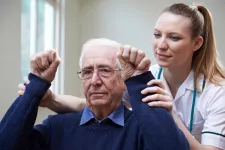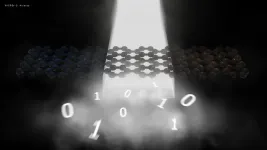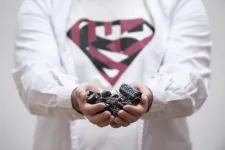It takes two to tango: When cells interact
2021-02-16
(Press-News.org) The fact that cells are motile and come into contact with each other is one of biology's fundamental principles. During embryonic development, cells must communicate with their neighbors in order to find their proper place in the differentiating organism. Wound healing is another process in which direct intercellular interactions are essential. In this context, motility enables cells to migrate to the location of the lesion and regenerate lost structures. Cancer cells also make use of this property to leave their site of origin in the primary tumor, which allows them to initiate the formation of metastatic tumors in other tissues.
"In recent years, biologists and physicists who study motility have mainly focused on investigating how large collectives comprising hundreds or thousands of cells coordinate their movements," says doctoral student David Brückner. His PhD supervisor Chase Broedersz is Associate Professor of Theoretical Biophysics at Ludwig-Maximilians-Universitaet (LMU) in Munich and the Vrije Universiteit (VU) in Amsterdam. "We wanted to know how pairs of cells interact when they come into contact, and set out to analyze their behavior using the methods of statistical physics."
Caged cells
To do so, Brückner and his colleagues fabricated a microscopic 'cage', which they refer to as a 'cell collider'. The use of defined geometries is a popular strategy in studies of cell motlity, but Alexandra Fink, a PhD student in the group led by Joachim Rädler, Professor of Biophysics and the Physics of Soft Matter at LMU, has now applied it in a novel context.
"The idea was to isolate two cells, while permitting them to interact in a restricted fashion," Brückner explains. This was achieved by placing single cells in each of two compartments that were connected by a narrow channel. This geometry meant that the cells could interact by extending thin membrane projections called protrusions, inevitably leading to collisions. The cell nuclei were labeled fluorescently to enable the movements of both cells to be monitored by fluorescence microscopy, so that the positions of the two could be tracked over time. "Based on the resulting experimental data, we were able to develop a model that provides a physical description of how the cells interact," says Brückner.
Evasive action on a microscopic scale
The observations revealed that when normal cells come into contact in the cell collider, their protrusions repel each other, and are then fully retracted. "When normal cells make contact, they tend to change direction so as to avoid the obstacle," says Brückner. This response to initial contact enables the cells to keep their distance from one another. "We were surprised to find that tumor cells behave in a very different way," Brückner adds.
In almost all cases, the two cancer cells tried to get past each other. With the aid of their theoretical model, the team was able to simulate this response in detail. The analysis revealed that, when two tumor cells approach each other they do not - as one might expect - slow down. Instead, they accelerate to squeeze past one another.
"These findings suggest two interesting approaches for further investigations," says Brückner. In the next step, the LMU team plan to identify the molecular bases for the very different interactions of the two cell types. Cancer cells are known to differ from their normal counterparts with respect to the sets of proteins exposed on their surfaces. Among them, cadherins - a specific class of proteins that play a vital role in mediating cell adhesion - are of particular interest.
Whether or not cadherins alone can account for the differences observed in the study is not yet known. In addition, the authors intend to examine whether bigger cell aggregates, such as those found in tumors, display patterns of motility similar to those exhibited by pairs of cells.
INFORMATION:
ELSE PRESS RELEASES FROM THIS DATE:
2021-02-16
An international study has shown, for the first time, that the capacity of the human brain to recover and rewire itself peaks around two weeks after a stroke and diminishes over time.
The finding, published today in the Neurorehabilitation and Neural Repair journal, is the result of a study in London and Adelaide that followed the recovery of 60 stroke patients up to one year after their stroke.
Lead author Dr Brenton Hordacre, from the University of South Australia, says the multi-site study showed conclusive evidence that the brain only has a small window of opportunity to more easily repair itself after stroke.
"Earlier animal studies suggested ...
2021-02-16
Icebergs are melting faster than current models describe, according to a new study by mathematicians at the University of Sydney. The researchers have proposed a new model to more accurately represent the melt speed of icebergs into oceans.
Their results, published in Physical Review Fluids, have implications for oceanographers and climate scientists.
Lead author and PhD student Eric Hester said: "While icebergs are only one part of the global climate system, our improved model provides us with a dial that we can tune to better capture the reality of Earth's changing climate."
Current models, which are incorporated into the methodology used by the Intergovernmental Panel on Climate Change, ...
2021-02-16
Over the past years, global data traffic has experienced a boom, with over 12.5 billion connected devices all over the world. The current world-wide deployment of the 5G telecommunications standard is triggering the need for smaller devices with enhanced performances, such as higher speed, lower power consumption and reduced cost as well as easier manufacturability.
In search for the appropriate technology, photonic devices emerged as the leading technology for the evolution of such information and communication technologies, already surpassing ...
2021-02-16
ADELPHI, Md. -- The Army of the future will involve humans and autonomous machines working together to accomplish the mission. According to Army researchers, this vision will only succeed if artificial intelligence is perceived to be ethical.
Researchers, based at the U.S. Army Combat Capabilities Development Command, now known as DEVCOM, Army Research Laboratory, Northeastern University and the University of Southern California, expanded existing research to cover moral dilemmas and decision making that has not been pursued elsewhere.
This research, featured in Frontiers in Robotics and AI, tackles the fundamental challenge of developing ethical artificial intelligence, ...
2021-02-16
The human condition is riddled with extreme events, which bring chaos into our lives. Natural disasters leave a trail of destruction, causing direct and horrible pain and suffering - costing lives, creating injuries, destroying houses, livelihoods, crops and broken infrastructures. While extensive research has been conducted on the economic and public healthcare costs of these types of disasters around the world, their effect does not end there. A team of researchers from the Hebrew University of Jerusalem sought to better understand the behavioral and social implications ...
2021-02-16
Psychotherapy for panic disorder produces good results, and the effects are lasting. That is the result from a large long-term study from Lund University in Sweden. Two years after treatment were 70 per cent of the patients clearly improved and 45 per cent were remitted.
Panic disorder is one of the most common causes of mental illness in Sweden and worldwide. Approximately 2 per cent have panic disorder. When untreated, the condition is associated with emotional distress and social isolation. Panic attacks often debut in adolescence or early adulthood and many of those affected ...
2021-02-16
We live in modern times, that is full of electronics. Smartphones, laptops, tablets, and many other devices need electrical energy to operate. Portable devices made our lives easier, so novel solutions in clean energy and its storage are desirable. Lithium-ion (Li-ion) batteries are the most common solutions that dominate the global market and are a huge problem due to their insufficient recovery. Because of their limited power, short cycle life, and non-environment-friendly nature, scientists recently focused on novel solutions like supercapacitors that offer much more than batteries. Why? Let's take a look closer at these devices.
Supercapacitors bring together the properties of a standard capacitor and the Li-ion battery. In practice, ...
2021-02-16
Following the civil war outbreak in Syria nearly ten years ago, Israel began admitting wounded Syrians into the country for humanitarian medical treatment.
In accordance with the Israeli government's decision, the Israel Defense Forces, medical corps, health care system and hospitals in the north of the country joined together to provide medical treatment to thousands of wounded Syrians. The logistics of evacuating the injured from the battlefield and transferring them to Israeli territory was often prolonged due to the fact that Israel and Syria are defined as enemy countries.
Most of the wounded were brought to the Galilee ...
2021-02-16
Biophysicists at Ludwig-Maximilians-Universitaet (LMU) in Munch have developed a new theory, which accounts for the observation that cells can perceive their own shapes, and use this information to direct the distribution of proteins inside the cell.
Many cellular processes are critically dependent on the precise distribution and patterning of proteins on the cell membrane. Diverse studies have shown that, in addition to protein-protein interactions and transport processes, cell shape can also have a considerable impact on intracellular pattern formation. Conversely, there are patterning processes in which any dependence on cell form would be deleterious. Using starfish oocytes as a model system, LMU physicists led by Professor Erwin ...
2021-02-16
In shallow water, less than 30 metres, the survival of hard corals depends on photosynthetic unicellular algae (zooxanthellae) living in their tissues. But how does the coral adapt at depth when the light disappears? French researchers from the CNRS, EPHE-PSL and their international collaborators, associated with Under the Pole (Expedition III), have studied for the first time the distribution of these so-called mesophotic corals in the French Polynesian archipelago, from the surface to 120 metres deep (with a record descent of 172 metres). As the amount of light decreases, the coral associates ...
LAST 30 PRESS RELEASES:
[Press-News.org] It takes two to tango: When cells interact



